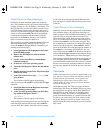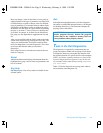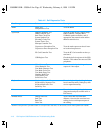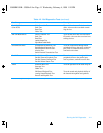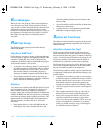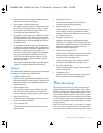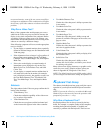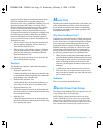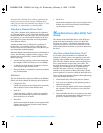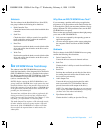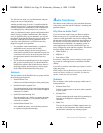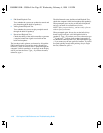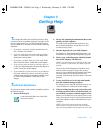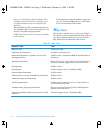
4-16 Dell Inspiron 3000 Reference and Troubleshooting Guide
You must have a diskette-drive cable to perform the fol-
lowing procedure. If you do not have a diskette-drive
cable, you can order one from Dell. See Chapter 5, “Get-
ting Help,” for information on contacting Dell.
Why Run a Diskette Drives Test?
Very often, a diskette drive problem may first appear to
be a diskette problem. A box of defective diskettes might
produce faulty-drive error messages. The test results can
be confusing, so you should run the subtests in the Dis-
kette Drives test group more than once using diskettes
from different sources.
Another possible cause of diskette drive problems is
human error—for example, typing a command in an
incorrect form (usually called a syntax error). Be sure you
have entered the command properly.
When the diskette and command syntax are eliminated as
causes, the following symptoms usually suggest a drive
problem and warrant running a subtest in the Diskette
Drives test group:
•
An error message appears on the screen stating that
the computer cannot read from or write to a diskette.
•
A diskette cannot be properly formatted, or format
error messages appear on the screen.
•
Data on diskettes is corrupted or lost; these problems
may be intermittent.
Subtests
The four diskette drive subtests available in the Diskette
Drives test group confirm the following drive functions:
•
Change Line Test
Checks for bent pins on the diskette drive controller
and for defective lines on the diskette cable
•
Seek Test
Checks the drive’s ability to search for a specified
track on the diskette and to position the read/write
heads of the drive to all tracks
•
Read Test
Positions the read/write heads at each cylinder of the
diskette and verifies that all tracks on the diskette
can be read correctly
•
Write Test
Positions the read/write heads at each cylinder of the
diskette and verifies that all tracks on the diskette
can be written to correctly
H
ard-Disk Drives (Non-SCSI) Test
Group
The subtests in the Hard-Disk Drives (Non-SCSI) test
group check the functionality of up to two hard-disk
drives of any capacity. The subtests check the storage
capability of a drive as well as the hard-disk drive con-
troller (which affects the ability to read from and write to
the drive).
Why Run a Hard-Disk Drives Test?
If you check your hard-disk drive to determine the
amount of available space, your operating system will
probably report problem areas. Problem areas on hard-
disk drives are common, because most hard-disk drives
have a small amount of space that is not usable. The
hard-disk drive keeps a record of this space so that the
computer will not attempt to use it. Identification of
unusable disk space, unless it is an unusually large
amount (over five percent of the possible total), should
not be regarded as a cause for testing the hard-disk drive.
These are the most common symptoms that might prompt
you to test the hard-disk drive:
•
The hard-disk drive fails during the boot routine.
•
Seek errors are reported by the operating system or
application programs.
•
An error message appears on the screen stating that
the computer cannot read from or write to the hard-
disk drive.
•
Data on the hard-disk drive is corrupted or lost; these
problems may be intermittent. Once saved by a pro-
gram, files cannot be properly recalled.
55899BK1.BK : 55899c41.fm Page 16 Wednesday, February 4, 1998 1:20 PM



